Antique Engagement Rings: A Detailed Exploration
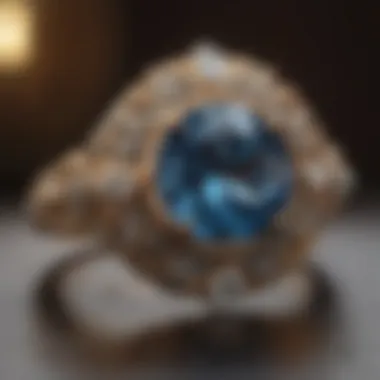
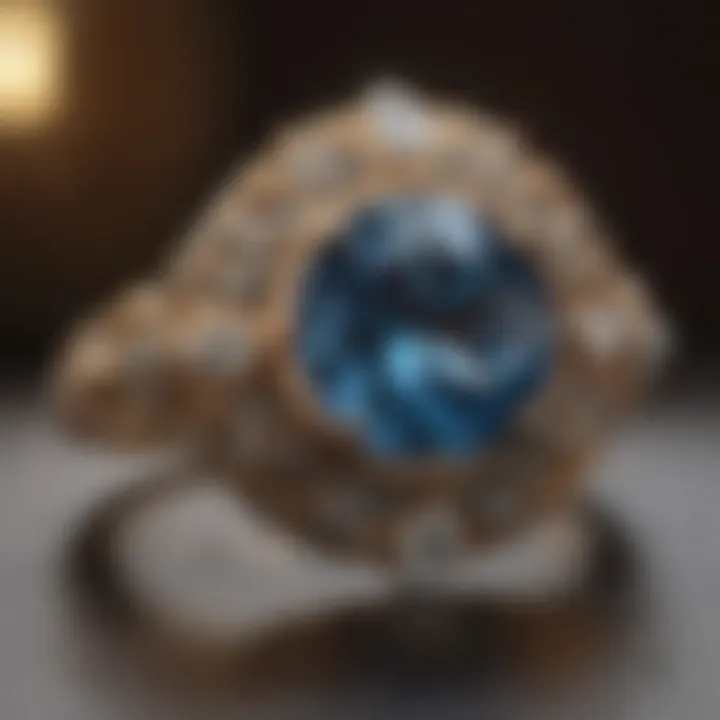
Intro
Antique engagement rings possess a charm that transcends the ages. These exquisite pieces are not merely symbols of love and commitment; they are artifacts steeped in rich history and artistry. In the world of fine jewelry, antique rings stand out for their unique characteristics and historical significance. One might say they carry stories within their very designs, encapsulating moments of romance from previous eras.
As couples seek originality in their engagement rings, antique pieces have grown increasingly popular. Their distinctiveness and the craftsmanship embedded in each ring resonate deeply with a generation that values sustainability and authenticity. This guide aims to provide a full exploration into those enchanting bands, detailing their historical backdrop, prevalent styles, craftsmanship, and how to care for these timeless treasures.
By understanding the nuances of antique engagement rings, individuals can navigate the fascinating landscape of gemstones that have adorned these pieces through time. Not only will you gain insight into the types of stones used, but also their enduring allure that captivates collectors and lovers alike.
Historical Context of Antique Engagement Rings
Understanding the historical context of antique engagement rings is crucial for appreciating their unique beauty and significance. Each ring tells a story, reflecting the social norms, technological advances, and cultural shifts of its time. Knowing the background helps collectors and enthusiasts discern the craftsmanship involved and realize the value attached. When someone opts for an antique engagement ring, they are not just choosing a piece of jewelry; they are selecting a piece of history adorned with stories of love and commitment.
Evolution of Engagement Rings
The evolution of engagement rings can be traced back to ancient civilizations, where various forms of jewelry symbolized love and intent to marry. In ancient Greece, it was customary for men to offer rings made of iron, signifying a bond that was intended to last a lifetime. As time wore on, the material transitioned from iron to more precious metals, illustrating a shift in societal values towards wealth and status.
During the Middle Ages, diamond engagement rings became a beacon of romance when Archduke Maximilian of Austria gifted a diamond ring to Mary of Burgundy in 1477. This gesture set a precedent, leading to the eventual popularity of diamond rings in the Victorian era. Couples began to crave lavish displays of devotion, seeking rings adorned with not just diamonds, but also colored gems, embracing a myriad of styles and settings that showcased the era’s flair.
As the centuries rolled on, changing trends in design and craftsmanship mirrored broader societal shifts. The Art Deco period, for instance, introduced innovative geometric designs and bold colors, moving away from the softer, romantic styles of earlier years. Each transition not only altered the aesthetic of engagement rings but also changed their meaning—reflecting contemporary views on love and partnership.
Cultural Influences in Design
Cultural backgrounds have always played a vital role in the design of engagement rings. As societies evolved and amalgamated diverse traditions, the significance and symbolism within jewelry became a fusion of ideas and influences.
For instance, the extravagant designs of Ottoman Empire jewelry weaved together Islamic motifs and precious gemstones, creating rings that were not only beautifully crafted but also steeped in rich cultural symbolism. Meanwhile, Asian influences brought in intricacies and attention to detail, often using jade or other meaningful stones, celebrating various aspects of love and prosperity.
In Africa, engagement rings often incorporate powerful symbolism, drawing upon tribal motifs and materials. Local artisans express love stories through unique designs, making each piece a testament to cultural heritage.
As globalization continues to interconnect traditions, we see new styles emerging, blending various cultural elements. Today, the designs of antique engagement rings remain entwined with the moments and memories that define relationships, grounding them in both history and the personal narratives of those who cherish them.
The evolution of engagement rings and their cultural significance offers a window into societies as much as into personal emotions, illustrating how love, tradition, and artistry intertwine through time.
Defining Characteristics of Antique Engagement Rings
Understanding the defining characteristics of antique engagement rings is essential for appreciating their unique charm and status. These rings distinguish themselves from modern designs through their intricate craftsmanship, distinctive styles, and the variety of gemstones used throughout different eras. Antique rings are not merely jewelry; they tell stories of love, tradition, and history. For gemstone enthusiasts and collectors alike, recognizing these defining features enhances the process of selecting a ring, ensuring that one chooses not just a piece of jewelry but a tangible connection to the past.
Craftsmanship and Artistry
When one looks closely at antique engagement rings, the quality of craftsmanship immediately stands out. These rings are often hand-crafted, reflecting the artisan’s skill and dedication. Master jewelers of the past utilized techniques that may not be common today. For example, tiny engravings, intricate filigree, and delicate metalwork can be found in many Victorian and Edwardian designs.
Moreover, the use of tools that were available in earlier times meant every piece carried a signature of its maker. This lack of mass production adds a layer of exclusivity and uniqueness. Many antique rings possess subtle imperfections that are a testament to their individual creation, hinting at the skill and care involved.
Key points of craftsmanship in antique engagement rings:
- Handmade techniques exhibit a high level of artistry.
- Unique designs reflect the jeweler’s signature style.
- Traditional methods may include tools and techniques no longer used.
Distinctive Settings and Styles
The settings and styles of antique engagement rings are telling of their specific period. Each era had distinct styles shaped by cultural influences and trends. For instance, rings from the Victorian era often feature romantic motifs and elaborate settings full of symbolism, while Art Deco rings are known for their geometric patterns and bold lines.
The settings themselves can vary greatly, including:
- Bezel Settings: Very common in earlier rings, these secure gemstones with metal around the edge.
- Prong Settings: A more modern approach, this lifts the stone up to reveal its brilliance.
- Cluster Settings: Often seen in vintage rings, where multiple stones create a floral or star-like look.
Exploring these distinctive features allows enthusiasts to recognize the charm of various styles. Individual taste certainly plays a role in selection, but understanding the historical context can elevate the choice to something even more meaningful.
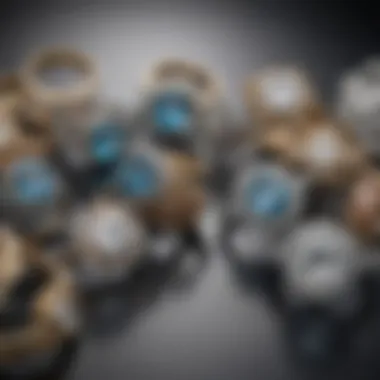
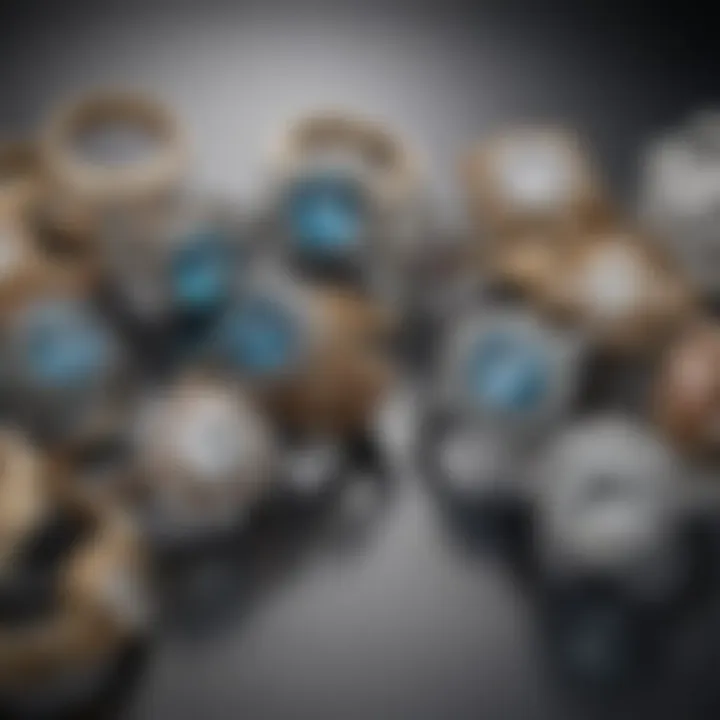
Gemstone Choices Over the Decades
The types of gemstones chosen for antique engagement rings also vary considerably over time. In earlier centuries, diamonds were often seen as a sign of affluence, but many rings feature a delightful assortment of colored stones. Popular choices include:
- Sapphires: Favored during the Victorian and Edwardian eras, especially in conjunction with diamonds for added brilliance.
- Emeralds and Rubies: These stones were often associated with royalty and were crafted into stunning pieces.
- Natural Pearls: These were immensely popular in the Victorian era, symbolizing purity and love.
The rise of different gemstones also mirrors the societal changes and trends that defined those times. The allure of a certain color or gemstone connects modern couples with their historical counterparts, embracing what was once notably cherished by those who came before them.
In essence, the defining characteristics of antique engagement rings offer more than just aesthetic appeal; they serve as a bridge across time, connecting lovers through shared histories and inspirations. Choosing an antique ring can resonate deeply, signifying not just a promise but a narrative rich in tradition and artistry.
Popular Antique Engagement Ring Styles
When it comes to choosing an antique engagement ring, understanding the various styles becomes crucial. Each style carries with it a unique flavor of history, craftsmanship, and cultural implication that can resonate deeply with the wearer. By recognizing these distinctions, potential buyers can make more informed decisions that not only reflect personal taste but also the rich stories attached to these treasured pieces.
Victorian Style Rings
Features of Victorian Designs
Victorian rings are often characterized by intricate detailing that speaks volumes of their era's artistry. Crafted during the reign of Queen Victoria from 1837 to 1901, these pieces often feature elaborate engravings and elaborate settings. A key trait of Victorian designs is the emphasis on sentimentality; many rings incorporated hidden meanings and symbols, such as hearts, flowers, and intertwining motifs. This not only showcases the craftsmanship but also adds layers of emotional significance to the piece.
The unique feature of these rings lies in the blend of various materials, including gold and silver, combined with exquisite gemstones. This adaptability allows for a wide array of choices for couples, ranging from modest to grand expressions of love. However, it’s important to consider that their intricate designs can require more maintenance than simpler styles, necessitating regular care to preserve their allure.
Popular Gemstones
In Victorian engagement rings, the choice of gemstones plays a central role. Diamonds were a popular choice, symbolizing eternal love, but colored gems like sapphires, rubies, and emeralds were not uncommon. Each gemstone carried its own symbolism and prominence during the Victorian era, adding a dash of individuality to the rings.
Notably, the use of colored gemstones in these rings often served a dual purpose – both to emphasize the personal touch of the wearer and to reflect the prevailing fashion trends. Beyond their beauty, these gemstones can also be more affordable alternatives to diamonds, offering couples an opportunity to purchase a unique piece without breaking the bank. However, one must carefully assess the quality of these stones, as not every vintage gem will have weathered time gracefully.
Edwardian Era Characteristics
Filigree Work
The Edwardian era, which blossomed from 1901 to 1910, is renowned for its intricate filigree work. This delicate metalwork involves twisting fine threads of gold or platinum into elaborate patterns, creating a lace-like effect that embodies the elegance of the time. The hallmark of Edwardian rings is their lightness and airiness, contrasting with the bolder Victorian styles.
Filigree work stands out for its artistry, blending craftsmanship with geometry. This level of detail not only enhances the beauty of a ring but also makes it a marvelous statement piece. Yet, it's essential to recognize that the delicate nature of filigree can render these rings more susceptible to damage, prompting careful handling and appropriate storage habits to maintain their structural integrity.
Use of Diamonds
The use of diamonds surged in popularity during the Edwardian period, becoming a quintessential feature of engagement rings. The advances in diamond-cutting technology allowed for brilliant cuts that maximized the stones' sparkle, captivating the wearer and onlookers alike.
Diamonds offered a timeless quality, further cementing their status as symbols of love and commitment. The combination of diamonds with other materials, especially in filigree settings, showcases a level of sophistication that draws many couples. Diamonds, while expensive, are incredibly durable, making them a wise investment for an engagement ring. However, prospective buyers should be wary of the quality. Evaluating cut, color, clarity, and carat weight (commonly referred to as the "Four Cs") is key to ensuring the purchase of a truly remarkable stone.
Art Deco Influences
Geometric Patterns
The Art Deco movement, which gained momentum in the 1920s, introduced a striking departure from prior styles. Characterized by bold geometric patterns and a vibrant sense of symmetry, Art Deco rings exhibit a modern sensibility that appealed to the youthful exuberance of the time. The emphasis on linear designs and contrasting forms set these rings apart, resonating with those who valued both uniqueness and boldness.
What makes geometric patterns a standout choice is their versatility; they can accommodate various gemstones and settings, easily matching a variety of personal styles. This adaptability, combined with the striking visuals, makes Art Deco rings an attractive option for many. However, one should consider that the bold motifs may not appeal to those who prefer more romantic or delicate looks.
Colored Gemstones
In keeping with the spirit of Art Deco, colored gemstones burst onto the scene, offering a striking contrast to the traditional diamond engagement ring. Designers of the era employed vibrant gems such as emeralds, rubies, and sapphires, reflecting not only personal preference but also the exuberance of the Roaring Twenties.
The unique feature of colored gemstones is their ability to convey individuality effectively; they allow for a customized touch that transcends mere jewelry, turning engagement rings into proud symbols of personality. While these gems can be more affordable and accessible than high-quality diamonds, their value must still be assessed based on clarity, cut, and overall desirability. As a result, colored gemstones present a fascinating and increasingly popular option within the realm of antique engagement rings.
Emotional and Symbolic Significance
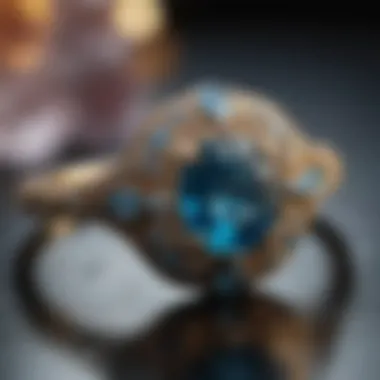
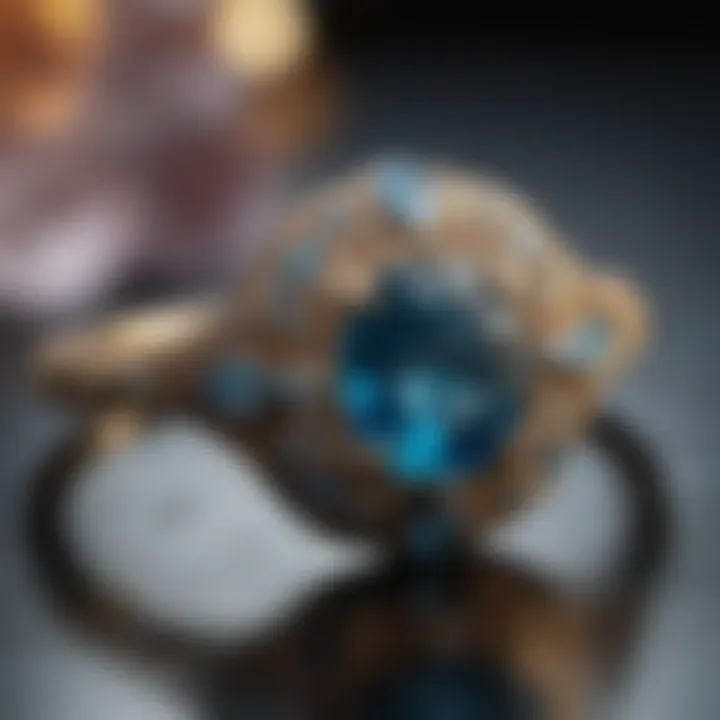
Antique engagement rings hold within them countless stories, emotions, and symbols, making them not just pieces of jewelry but vessels that carry deep meanings. The allure of these rings is not merely in their intricate designs or vintage charm; it often lies in their sentimental tales. They reflect personal journeys, represent love, and forge connections between past and present in ways that new jewelry simply can’t replicate.
Sentimental Value of Antique Rings
When one talks about sentimental value, it’s hard to ignore that old adage: "they just don’t make them like they used to." Antique rings, with their unique histories and craftsmanship, often evoke emotions that modern pieces struggle to match.
- Craftsmanship: Each ring tells a story of a craftsman’s skill, labor, and artistry. The marks left by hand tools or subtle imperfections speak to the ring's history, whispering secrets from a bygone era.
- Personal Stories: Many antique rings have exchanged hands through generations. They might have been an engagement ring passed down from grandmother to mother, each wearer adding her own layer of emotion and significance.
- Symbol of Commitment: An antique engagement ring symbolizes not just love but a commitment that has stood the test of time. When one sees such a ring, it often conjures images of romantic portraits painted long ago, of love letters hidden within a drawer.
In essence, antique rings are more than jewelry; they are time capsules filled with love, commitment, and personal histories.
Connection to Family Heritage
The connection that antique engagement rings have to family heritage can’t be overstated. They weave a tapestry of personal and shared histories that enrich one’s sense of identity.
- Legacy: Wearing a family heirloom, like an antique engagement ring, can instill a sense of belonging to something greater. It’s a tangible piece connecting the present with the past, linking owners to relatives they may never have met but whose stories live on through the ring.
- Cultural Significance: Different cultures often have their own customs regarding engagement rings, and an antique piece can embody these customs and traditions, making it inherently meaningful. A ring might reflect specific cultural designs or materials that resonate with one’s heritage, adding depth to its significance.
- Storytelling: Sharing the story behind an antique ring can be a focal point in family gatherings. It can prompt conversations about history, love stories, and the journey of one’s family. This storytelling aspect provides an emotional bond that new rings simply lack.
"Antique engagement rings can serve as gateways to the past, reminding us of who we are, where we come from, and the love that has shaped our family stories."
As we navigate through the process of selecting a ring or assessing its value, it’s crucial to recognize the deeper emotional connections these vintage pieces foster. They remind us that engagement, at its core, is a profound promise not just between two individuals, but also between generations.
Choosing the Right Antique Engagement Ring
Choosing the right antique engagement ring is not merely about selecting a beautiful piece of jewelry; it is a decision that intertwines personal taste with significant historical and emotional implications. With so many options available, understanding the specifics in this category is essential in making a selection that resonates with you both aesthetically and sentimentally. The ring you choose should not only symbolize your commitment but also reflect the timeless elegance of its era.
Setting a Budget
Understanding how to set a budget is fundamental when embarking on this journey. Antique rings can vary significantly in price based on their age, craftsmanship, and condition. It’s crucial to consider your financial capabilities while ensuring you still find something that you truly adore. Having a clear budget in mind helps filter choices, preventing you from falling in love with items that are beyond your financial reach.
Here are a few pointers to consider while budgeting for your antique engagement ring:
- Research Prices: Familiarize yourself with the general price ranges for different styles. For example, Victorian rings often command a higher price due to their intricate designs.
- Factor in Condition: Rings needing restoration or repair may initially appear less costly but can end up being pricier in the long run.
- Consider Resale Value: Think about how well the ring may hold its value over time, especially if you’re planning to invest.
Assessing Quality and Authenticity
When choosing an antique engagement ring, assessing the quality and authenticity cannot be overstated. You want a ring that not only appears stunning but also carries the weight of historical significance and craftsmanship.
Factors to Consider
When evaluating the quality of an antique ring, there are various factors you should weigh. Condition is paramount. Look for any signs of wear that could indicate poor maintenance or potential fragility. For example, a ring with loose gemstones might need immediate attention, indicating its past might not be as secure or favorable. It's wise to:
- Examine the Setting: Ensure the gemstones are secure and the metal is intact. This is important not just for aesthetics but also for durability, as fragile settings can easily lead to loss.
- Look for Hallmarks: Many antique rings have stamps that indicate the maker or the purity of the metal. These can lend credibility to the piece’s authenticity.
- Know the Style: Being knowledgeable about the design characteristics of specific periods can help you quickly determine if the ring fits its purported age.
Where to Find Reliable Sources
Finding reliable sources when procuring an antique engagement ring is a key step in ensuring you make a sound investment. Various avenues are available, but navigating them correctly can make all the difference.
- Reputable Jewelers: Seek out jewelers who specialize in antique pieces. They can often provide documentation about the ring’s age and history, ensuring its authenticity.
- Online Platforms: Websites like Reddit might offer valuable insights on where to find quality antique rings, as well as community recommendations on trustworthy sellers.
- Antique Shows and Fairs: These venues often present a plethora of options, allowing potential buyers to engage with sellers directly and inspect pieces closely.
However, beware the potential downsides. Online marketplaces can sometimes feature items without thorough verification, making it essential to scrutinize sellers before making a purchase. One must approach each source with a critical eye to ensure authenticity and provenance.
"An antique engagement ring is not just an ornament; it bears stories of love, loss, and the passing of time. Approaching the selection with both heart and mind is crucial."
Taking the time to set a sensible budget and ensure quality and authenticity will serve you well in your search for the perfect antique engagement ring. With careful consideration, you can find a piece that not only represents your love but also carries with it a rich history of its own.
Caring for Antique Engagement Rings
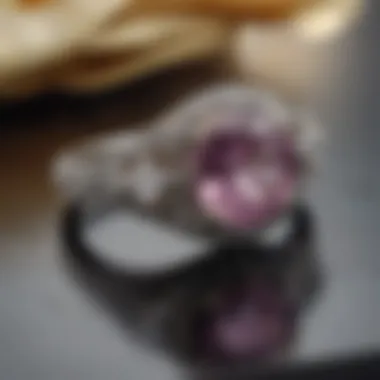
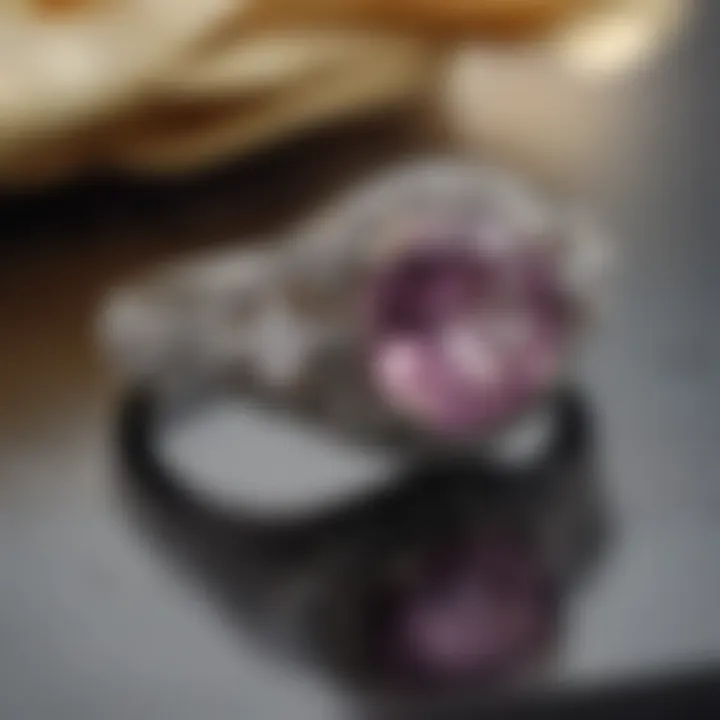
Caring for antique engagement rings is not just about maintaining their beauty; it is also about preserving the rich stories and histories embedded within these timeless pieces. These rings, often delicate and intricately crafted, have survived the test of time thanks to their enduring craftsmanship. However, without proper care, their value might diminish or they could suffer damage.
The importance of this section lies in understanding the specific needs these old rings have compared to modern pieces. Regular maintenance and proper storage practices are essential for keeping the allure of these antique rings alive. Failure to maintain them could lead to losses not just in monetary values but also in the sentimental connections they hold.
Regular Maintenance Tips
To ensure that your antique engagement ring continues to dazzle for years to come, regular maintenance becomes vital. Here are some tips worth considering:
- Gentle Cleaning: Use a soft, lint-free cloth to wipe down the ring frequently, which helps remove dirt or oils that accumulate from daily wear. For deeper cleaning, mix a few drops of mild dish soap in warm water and soak the ring for about 10 to 15 minutes. A soft brush, like a toothbrush, can gently dislodge any debris.
- Professional Checkups: Every few years, consider taking the ring to a professional jeweler who understands antique jewelry. They can check for loose stones, worn settings, and other potential issues. Changing prongs and tightening loose stones can save the ring from significant damage in the long run.
- Avoid Harsh Chemicals: Old pieces can be more vulnerable to harsh chemicals. Avoid cleaners with ammonia or bleach, as they can tarnish metals or affect gemstones adversely.
Remember, the craftsmanship in antique rings is often delicate, and one wrong move could result in costly repairs.
Proper Storage Practices
Storing your antique engagement ring properly is equally important as maintaining it. When not worn, how you store it can determine its longevity. Here are a few essential practices:
- Separate Storage: Store your antique ring in a separate compartment of a jewelry box or in a soft pouch to prevent scratches from other pieces. Rings can easily get damaged from being banged against one another.
- Cool, Dry Environment: Antique rings should be kept away from excessive heat or humidity, which can cause metal to warp or gemstones to degrade. A cool, dry place will help maintain their structural integrity.
- Avoid Exposure to Sunlight: Extended exposure to direct sunlight can fade colors in gemstones or even change the hue of metals over time.
When you treat these beautiful antique pieces with the respect they deserve, you not only prolong their life but also ensure that they remain cherished artifacts, rich with history.
"Antique rings are not just pieces of jewelry; they are cherished mementos that tell stories across generations. Care for them well, and they will keep those stories alive."
Modern Trends in Antique Engagement Rings
The world of antique engagement rings has undergone a noticeable transformation in recent years. As the desire for unique and historical pieces grows, so too does the emergence of modern trends that blend vintage charm with contemporary flair. It's not merely nostalgia that drives this movement; it’s a profound appreciation for craftsmanship, story, and individuality. In this section, we'll explore how vintage styles are being revived and the significant influence of social media in shaping and popularizing these trends.
Revival of Vintage Styles
The revival of vintage styles is more than just a passing fad; it’s a full-fledged renaissance of craftsmanship and aesthetic sensibilities that characterized bygone eras. Couples today are increasingly drawn to engagement rings that not only represent their commitment but also tell a story.
Many modern couples appreciate the intricate details and unique designs found in antique rings. They often find themselves captivated by styles such as Art Deco and Victorian, which present a stark contrast to the mass-produced jewelry dominating contemporary markets. Some reasons for this revival include:
- Individuality: Each antique ring carries a unique history and character, allowing wearers to express their personal style in a distinctive way.
- Sustainability: Choosing antique or vintage rings is seen as an eco-conscious decision. Reusing resources that have already been crafted can reduce the demand for newly mined gems and metals.
- Inherent Value: Antique rings often possess a greater intrinsic value than modern rings due to their rarity and craftsmanship, making them not just a purchase, but an investment.
- Sentimental Connections: Many individuals are motivated by family heirlooms and sentimental values, seeking to honor heritage while embracing personal love stories.
For example, someone might inherit a beautiful Edwardian ring from a grandparent and choose to restore it for an engagement, adding layers of meaning that a new piece simply might not provide.
Influence of Social Media
The role of social media in popularizing antique engagement rings cannot be overstated. Platforms like Instagram and Pinterest have turned into treasure troves for those seeking inspiration and connection to vintage aesthetics. They provide a vibrant means for enthusiasts to share their finds, customizing rings to reflect not just personal taste, but also current trends.
Here’s how social media is changing the game:
- Visual Inspiration: On sites like Instagram, hashtags such as #AntiqueEngagementRing or #VintageJewelry entice those in search of unique pieces. Beautiful photos showcase the details, encouraging new collectors to enter the market.
- Community Building: Online communities and forums on platforms like Reddit enable enthusiasts and collectors to share advice, swap stories, and recommend trusted sellers and jewelers, creating a rich dialogue around antique rings.
- Market Awareness: Social media allows consumers to become educated about different styles, historical significance, and even current market prices. This knowledge empowers buyers and helps them make informed choices when purchasing a ring.
- Quirkiness and Personalization: Couples can now curate a ring that not only fits their style but also speaks to their relationship narratives. Vintage rings often feature unique stones and styles not typically found in modern rings, allowing couples to showcase their creative sides.
"The beauty of antique engagement rings lies in their stories. Each piece holds a life lived, waiting for a new chapter."
The blending of these trends—the embrace of historical significance paired with modern social connectivity—ensures that the appeal of antique engagement rings will endure. As society continues to seek authenticity and connection, these exquisite pieces of the past are firmly anchored in the present.
Epilogue: The Timeless Allure of Antique Engagement Rings
The significance of antique engagement rings lies not just within their aesthetic charm, but also in the stories they carry and the eras they symbolize. These rings act as magnificent time capsules, capturing the essence of love and commitment from different periods in history. As we explored throughout this article, the evolution of engagement rings reflects cultural shifts, advancements in craftsmanship, and changes in societal norms surrounding love and marriage. This deep connection to history elevates antique engagement rings from mere decorative items to cherished heirlooms with profound meaning.
Enduring Appeal and Legacy
Antique engagement rings have an undeniable appeal that resonates with many. Their uniqueness is an echo of a bygone era, offering a refreshing contrast to the more mass-produced modern rings of today. Here are key elements that contribute to their legacy:
- Craftsmanship: The artistry involved in creating antique rings showcases unparalleled skill. Jewelers of the past often employed techniques that are rarely seen today. For instance, intricate engraving or delicate filigree work adds a layer of depth that simply can't be replicated by contemporary machinery.
- Material Quality: Many antique rings are made from high-quality materials that have endured the test of time. Gold alloys and carefully selected gemstones were often chosen for their beauty and durability, which continues to be appreciated by today’s enthusiasts.
- Romantic Symbolism: Each antique ring holds a narrative, whether it's the love story of its original owner or the history of the period it represents. This personal connection can deepen emotional ties for couples today, enhancing the sentiments associated with their engagement.
"Antique engagement rings are not just jewelry; they are gateways to the past," notes a passionate collector from a discussion on reddit.com.
- Sustainability: Choosing an antique ring often aligns with principles of sustainability. They don’t require new mining for materials, and opting for vintage styles taps into a growing movement of rediscovering and cherishing what already exists. This factor notably appeals to environmentally conscious couples.
In summary, antique engagement rings are timeless treasures, rich in history and significance. Their allure lies in their craftsmanship, unique designs, and the intimate narratives they hold. As society continues to evolve, these rings remain steadfast, serving as poignant reminders of love's enduring nature and the legacy left behind. Embracing one not only celebrates personal love stories but also honors the artistry and legends of the past.



